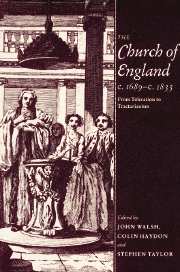Book contents
- Frontmatter
- Contents
- Preface
- List of Abbreviations
- 1 Introduction: The Church and Anglicanism in the ‘long’ eighteenth century
- Part I The pastoral work of the Church
- Part II Crisis and reform
- Part III Identities and perceptions
- 13 The eighteenth-century Church: a European view
- 14 Portrait of a High Church clerical dynasty in Georgian England: the Frewens and their world
- 15 ‘Papist traitors’ and ‘Presbyterian rogues’: religious identities in eighteenth-century Lancashire
- 16 Church parties in the pre-Tractarian Church of England 1750–1833: the ‘Orthodox’ – some problems of definition and identity
- Index
14 - Portrait of a High Church clerical dynasty in Georgian England: the Frewens and their world
Published online by Cambridge University Press: 13 October 2009
- Frontmatter
- Contents
- Preface
- List of Abbreviations
- 1 Introduction: The Church and Anglicanism in the ‘long’ eighteenth century
- Part I The pastoral work of the Church
- Part II Crisis and reform
- Part III Identities and perceptions
- 13 The eighteenth-century Church: a European view
- 14 Portrait of a High Church clerical dynasty in Georgian England: the Frewens and their world
- 15 ‘Papist traitors’ and ‘Presbyterian rogues’: religious identities in eighteenth-century Lancashire
- 16 Church parties in the pre-Tractarian Church of England 1750–1833: the ‘Orthodox’ – some problems of definition and identity
- Index
Summary
Hanoverian England was a hostile environment for High Churchmen. To them it seemed that virtually everything they fought for – divine right hereditary monarchy, religious conformity and scrupulous orthodoxy – was being threatened, if not utterly destroyed. Nevertheless, many refused to capitulate to the pressure applied by the political and ecclesiastical establishments to sell out, and High Churchmanship persisted, despite many countervailing pressures. Since they felt that their most sacred principles were being severely undermined by forces in Church, government and society, High Churchmen clung to their ideals all the more tightly, and determined to hold their ground against the foes who assailed them.
What induced men to remain High Churchmen? If these were men truly out of step with the times, why did they persevere? And how did they interact in a society in which so many stood against what they stood for? Was their opposition rooted in piety or in other social factors?
These are difficult questions to answer for it is no simple task to discern the ethos of parish priests, most of whom left no record of their thoughts. A few cases exist, however, where these issues can be looked at in detail. One of these is the Frewen family, a clerical dynasty which began in the late sixteenth century and lasted well into the nineteenth. This essay relates how the Frewens, as traditionalists, coped with and adjusted to the hostility of Georgian England.
- Type
- Chapter
- Information
- The Church of England c.1689–c.1833From Toleration to Tractarianism, pp. 299 - 316Publisher: Cambridge University PressPrint publication year: 1993



